
Nikole Hannah-Jones
When New York Times correspondent Nikole Hannah-Jones won the Pulitzer Prize for commentary for an article she published about blacks and the ideal of America, her own newspaper reported, “The essay was published on Aug. 14, and the magazine issue gained public attention immediately, with copies selling out and educators around the country teaching The 1619 Project.”
That the Pulitzer was for “commentary” rather than history, national reporting, or some other more empirically anchored category generated some amusement in competing newsrooms. Given all the theatrics that have attended the article’s publication, it’s possible that the most appropriate award the Pulitzer Board could have chosen to honor The 1619 Project or Hannah-Jones with would have been the prize for drama.
“Educators around the country” are indeed “teaching The 1619 Project.” What, precisely, students and other interested observers are learning is another question. The 1619 Project is certainly educational, or at least instructive—but not only in the ways it was intended.
What The 1619 Project Is
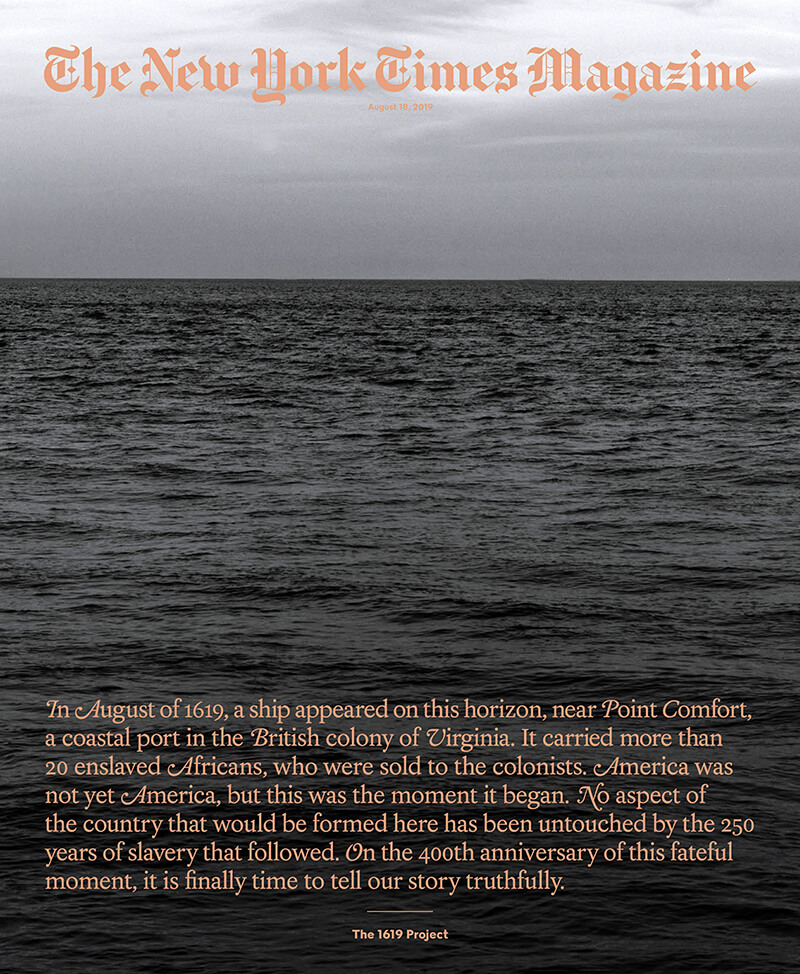
The 1619 Project was, and is, sprawling and ambitious. It takes its name from the year of arrival in Virginia of a ship carrying African slaves. An introduction by the editor of the New York Times Magazine, Jake Silverstein, explained, “The goal of The 1619 Project is to reframe American history by considering what it would mean to regard 1619 as our nation’s birth year. Doing so requires us to place the consequences of slavery and the contributions of black Americans at the very center of the story we tell ourselves about who we are as a country.”
A special issue of the glossy print New York Times Magazine dedicated to the theme included essays by journalists and academics. These were accompanied by poetry and by other articles that were labeled as fiction or “literary works.” A special broadsheet newsprint section included a brief history of slavery, created in partnership with the Smithsonian’s National Museum of African-American History and Culture. There was an article about what a headline termed “educational malpractice: why slavery is mistaught—and worse—in American schools.”
There was an accompanying podcast and an elaborate interactive website. All of it was presented in the sort of breathless-yet-authoritative tone that the Times usually reserves for document-based hard-news scoops such as the Pentagon Papers or a decades-old Donald Trump tax return.
In the Classroom
The Pulitzer Center on Crisis Reporting, a Washington, D.C.-based nonprofit that is unaffiliated with the Pulitzer Prizes, released lesson plans and reading guides aimed at bringing The 1619 Project into classrooms. One of the two lesson plans the Pulitzer Center issued during the six months after the project was published focused on the magazine essay by Hannah-Jones. Schools or school districts in Chicago; Newark, N.J.; Buffalo, N.Y., and Washington, D.C. all announced 1619 Project-related events. The Pulitzer Center’s annual report says more than 3,500 classrooms used the materials. Nikole Hannah-Jones spoke at the Whitney Young Magnet High School in Chicago, at Weequahic High School in Newark, at R.J. Reynolds High School in Winston-Salem, North Carolina, and at Washington D.C.’s Dunbar High School. She’s a regular presence on college campuses, with appearances in 2020 at Williams College, Morehouse College, Harvard Business School, Stanford, the University of Virginia, and the University of Michigan.
Random House Children’s Books announced plans to publish four 1619 Project books for young readers—one young adult, one middle-grade, and two picture books. Upfront, a newsletter that the New York Times produces for schools with the publisher Scholastic, used the 1619 label on an article about 1960s student activism for civil rights and desegregation, linking that to “the Climate March to demand action on global warming, and March for Our Lives to call for an end to gun violence.”
Stephanie Manzella, a teacher at Concord Academy, a private school in Concord, Massachusetts, told me that she used the introductory essay by Hannah-Jones, as well as 1619 Project articles on medicine and mass incarceration, in a class for high school juniors and seniors. At the end of the course, the students taught three workshops to the rest of the school on what they learned.
Meghan Thomas, who was the 2016 Illinois history teacher of the year, teaches U.S. history to sophomores and juniors at Von Steuben Metropolitan Science Center, a public magnet high school in Chicago. She used Nicole Hannah-Jones’s essay in her class. The essay begins with a personal story about Hannah-Jones’s father, and Thomas said she thought her students, who are mostly Hispanic or black, “connected with her.” Thomas said she used the Hannah-Jones essay along with another article by historian Edmund Morgan called “Slavery and Freedom: The American Paradox,” to show that there are “a lot of different ways to talk about American history.”
In many schools, individual teachers have considerable discretion to add material like The 1619 Project essays without seeking authorization from any central authority. Laquisha Hall, who teaches 9th and 11th grade English at the Carver Vocational Technical High School in the Baltimore City Public Schools in Maryland, calls herself a “renegade.” She says that she has an official curriculum, but “I teach around it because some of it I don’t like. And I have felt that there were a lot of things missing.” Hall, who teaches predominantly black students, said the materials from The 1619 Project “just opened their eyes to learning more about their history.”
Hall said she asked her students to write about their reactions to the material. “They were shocked. I’d say they didn’t know people could treat others that way. They wished they’d learned it sooner. They wanted to do more research and find out more. They wanted to know why blacks were treated that way and not another race. And they wanted to know what would happen if slavery came back, how they would act. They had no idea that any black people fought back. They only knew about Malcolm X and Martin Luther King Jr.”
The teachers and students who used The 1619 Project material in class were enthusiastic—and understandably so. The goal of engaging students in learning about American history and the role slavery and black Americans have played in it is widely and justifiably shared. That goal animated some earlier successful and ongoing programs such as the Gilder Lehrman Institute of American History, which has trained thousands of educators about teaching slavery.
The Reaction
The reaction from certain other voices to The 1619 Project, though, was hostile, dismissive, and vehement. Some of this was unapologetically political, and it came from both ends of the ideological spectrum.
The World Socialist Website, which was particularly energetic in its opposition to The 1619 Project, acknowledged its concerns were grounded in the possibility that too much attention to race might set back working-class solidarity. “The historical slogan of the socialist movement is ‘Workers of the World, Unite!’ not ‘Races of the World, Divide!’” wrote David North and Eric London.
Ryan Williams and Matthew Peterson of the conservative Claremont Institute, writing in the New York Post, also warned against identity politics—not for undermining any incipient socialist revolution, but for eroding individualism. “The new moral and philosophical foundation for America envisioned by 1619 is based on the abandonment of the individual equality of rights under the law for a racial and identity politics based on group rights. These groups are to be arranged in a new caste system based on the groups’ varying histories of oppression,” they wrote. They warned, in language almost as breathless as that of The 1619 Project itself, that, “Every American and every political leader — from the local school board to the national legislature — must start thinking creatively and acting aggressively to deny the 1619 Project legitimacy and efficacy. What is at stake is nothing less than the dissolution of America.”
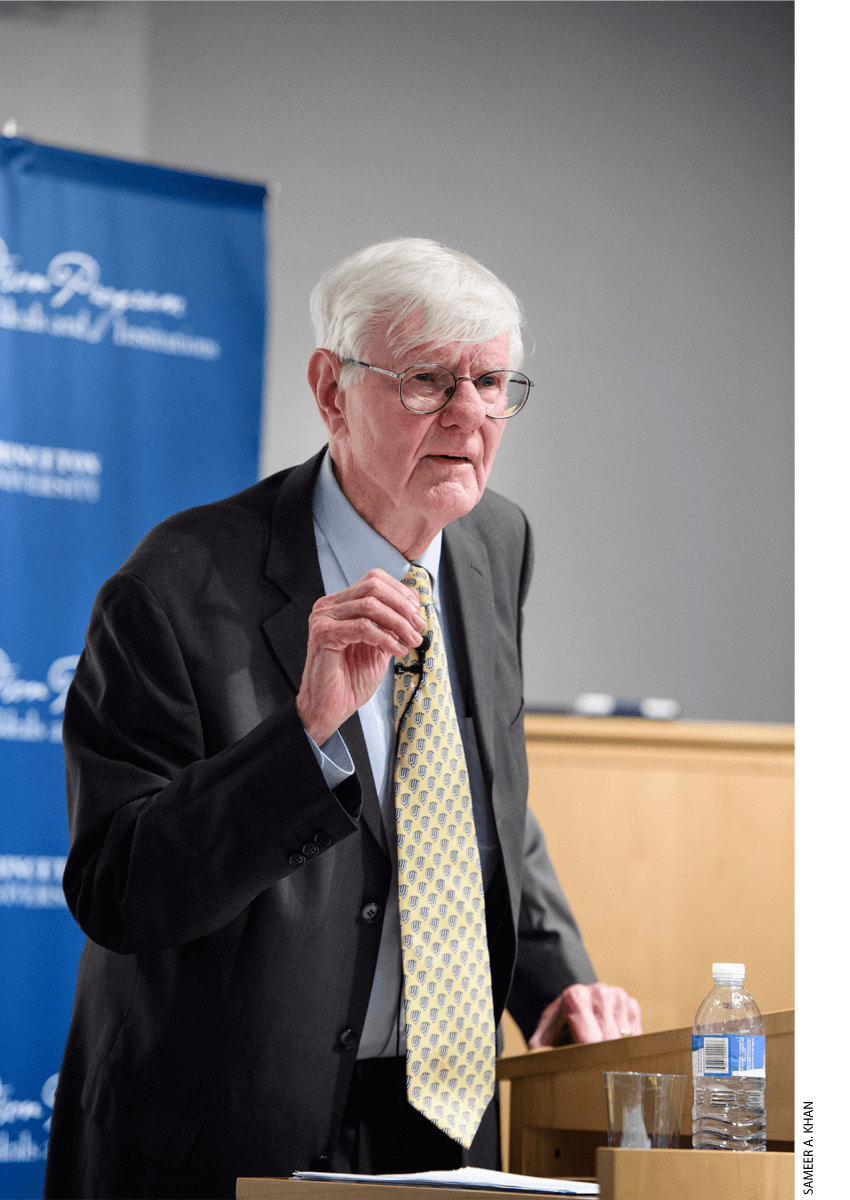
Gordon Wood
A former Israeli ambassador to Washington, Zalman Shoval, even took to the pages of the Jerusalem Post to denounce The 1619 Project as “fake history.” “The Nazis and the Bolsheviks were experts at engineering history to serve their political purposes and so are Palestinian leaders,” Shoval wrote, sensing “political affinity” between Hannah-Jones and the “anti-Israel” caucus in Congress that favors boycott, divestment, and sanctions against Israel.
More troublingly for The 1619 Project, several academic historians also found fault with the articles published by the New York Times, both in terms of details and narrative thrust. In December, five historians wrote a letter to the editor pointing out what they called “factual errors” in the 1619 essays. Gordon Wood, Victoria Bynum, James McPherson, Sean Wilentz, and James Oakes wrote, “the project asserts the founders declared the colonies’ independence of Britain ‘in order to ensure slavery would continue.’ This is not true. If supportable, the allegation would be astounding—yet every statement offered by the project to validate it is false.”
Further, the five historians wrote, “The project criticizes Abraham Lincoln’s views on racial equality but ignores his conviction that the Declaration of Independence proclaimed universal equality, for blacks as well as whites, a view he upheld repeatedly against powerful white supremacists who opposed him. The project also ignores Lincoln’s agreement with Frederick Douglass that the Constitution was, in Douglass’s words, ‘a GLORIOUS LIBERTY DOCUMENT.’ Instead, the project asserts that the United States was founded on racial slavery, an argument rejected by a majority of abolitionists and proclaimed by champions of slavery like John C. Calhoun.”
The Times originally dismissed the criticisms by historians, but pressure grew on the editors. An article in Politico headlined “I Helped Fact-Check the 1619 Project. The Times Ignored Me” described the Times’ interaction with a history professor at Northwestern University, Leslie Harris, who specializes in pre-Civil War African American history from the time of the slave trade through the Civil War. As Harris explained:
I had received an email from a New York Times research editor. … she sent me this assertion: ‘One critical reason that the colonists declared their independence from Britain was because they wanted to protect the institution of slavery in the colonies, which had produced tremendous wealth. At the time there were growing calls to abolish slavery throughout the British Empire, which would have badly damaged the economies of colonies in both North and South.’ I vigorously disputed the claim. Although slavery was certainly an issue in the American Revolution, the protection of slavery was not one of the main reasons the 13 Colonies went to war.
Despite my advice, the Times published the incorrect statement about the American Revolution anyway .…In addition, the paper’s characterizations of slavery in early America reflected laws and practices more common in the antebellum era than in Colonial times, and did not accurately illustrate the varied experiences of the first generation of enslaved people that arrived in Virginia in 1619.
The Times had issued a correction to the Hannah-Jones essay in August 2019, shortly after it was published, “An earlier version of this article referred incorrectly to the signing of the Declaration of Independence. It was approved on July 4, 1776, not signed by Congress on that date. The article also misspelled the surname of a Revolutionary War-era writer. He was Samuel Bryan, not Byron.” In March 2020, it added an “editor’s note”: “A passage has been adjusted to make clear that a desire to protect slavery was among the motivations of some of the colonists who fought the Revolutionary War, not among the motivations of all of them.” Yet in publishing the editor’s note, the Times Magazine editor, Jake Silverstein, insisted, somewhat defensively, “We stand behind the basic point.”
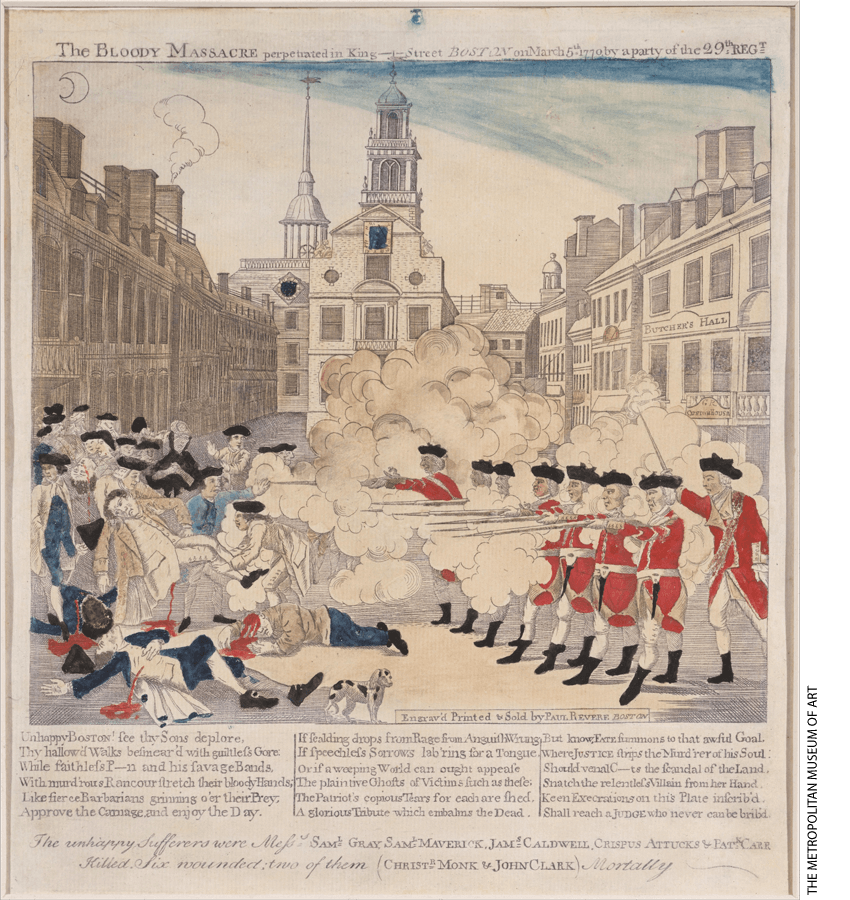
An early image of The Boston Massacre includes Crispus Attucks among the “unhappy sufferers”.
The Case of Crispus Attucks
What, precisely, was that “basic point”? Not to give an accurate accounting of the history. To grasp the trouble that The 1619 Project had with that mission, consider two sentences from the essay by Hannah-Jones. The Pulitzer Center “lesson plan” for “all grades” includes the instruction “Read Nikole Hannah-Jones’ essay in full,” so it’s not speculative that this would be material assigned to students. The essay says in part, “The very first person to die for this country in the American Revolution was a black man who himself was not free. Crispus Attucks was a fugitive from slavery, yet he gave his life for a new nation in which his own people would not enjoy the liberties laid out in the Declaration for another century.” Those two sentences break down into at least four separate checkable facts: that Crispus Attucks “was a black man,” that he was “not free,” that he was “the very first person to die for this country in the American Revolution” and that he “gave his life for a new nation.” Not a single one of those claims is precisely true.
To call Crispus Attucks “a black man” is an oversimplification. It neglects that he seems to have also had Native American ancestry. Mitch Kachun, a professor of African American history, wrote a book called First Martyr of Liberty: Crispus Attucks in American Memory, published in 2017 by Oxford University Press. Kachun writes, “Multiethnic people like Crispus Attucks were very much a part of eighteenth-century America… In Attucks, the three primary ethnic and racial strains of American identity—African, European, and Native American—came together.” Newspaper accounts at the time identified him as “the Molatto.” Kachun writes that “Identity in the eighteenth-century Atlantic world could be fluid and variable. … And any deeper attachments Attucks may have had to his African, Indian, or perhaps even European roots are far beyond what the existing sources reveal.” J.L. Bell, the proprietor of the Boston 1775 website, who knows a lot about this and is cited by Kachun, has written that in the contemporaneous accounts by Boston Massacre witnesses and in the trial that followed, “There are over a dozen references” to Attucks “as a ‘mulatto’ or ‘molatto,’ and one each as an ‘Indian,’ a ‘tall man,’ and a ‘stout [i.e., muscular] man.’ No one in those publications referred to Attucks as a ‘Negro’ or ‘black man,’ terms used for other men in that period.”
Then there is the claim that Attucks “was not free.” As with the claim that Attucks was black, Hannah-Jones cites no evidence. There were three newspaper advertisements placed in the Boston Gazette in the fall of 1750 offering a reward for “a Molatto Fellow” named “Crispas” who ran away from his master, but even if Crispus and Crispas were one and the same, as they likely were, the 1750 ad is hardly dispositive about the status of Crispus Attucks in 1770, at the time of the Boston Massacre. There were free blacks and free mixed-race formerly enslaved individuals in Massachusetts at this time, both documented and undocumented, according to “The Legal Emancipations of Leander and Caesar: Manumission and the Law in Revolutionary South Carolina and Massachusetts,” a 2007 article by Emily Blanck in the journal Slavery & Abolition. Samuel Adams was reported by his niece to have freed a female slave named Surry in 1764 or 1766, according to a biography of Adams published in 1866. “A free man or a fugitive slave?” Kachun wonders about Attucks, observing that “With almost no concrete evidence concerning Attucks’s life, we must rely almost entirely on speculation.” A 2017 book by Eric Hinderaker published by Harvard University Press, Boston’s Massacre, makes a similar point, with similarly nuanced and responsible attention to the limits of the source material that is available: Attucks “may have been an escaped slave himself, though the evidence is inconclusive.” Some scholars, such as Jared Hardesty in his 2016 book Unfreedom: Slavery and Dependence in Eighteenth Century Boston, have emphasized that even blacks who won their legal freedom had lower status than white male landowners. But so did unmarried white women. Attucks was sufficiently free to attend, apparently of his own volition, the street protest that became the Boston Massacre.
“The very first person to die for this country in the American Revolution”? Not just one of the first, but the “very first”? Actually, in Boston, Christopher Seider, age 11, had been shot and killed by a loyalist customs informer, Ebenezer Richardson, during a protest on February 22, more than a week before the March 5 Boston Massacre. Seider has a stronger claim than does Attucks to the distinction of being first to die in the cause that became the American Revolution. As for the massacre victims, the events are shrouded in the fog of war. “On several key issues, we have no way of knowing what actually happened,” Hinderaker writes. Contemporaneous newspaper accounts, depositions of witnesses, and trial testimony indicate that Samuel Gray, Crispus Attucks, and James Caldwell were all killed instantly and essentially simultaneously at the scene.
“Gave his life for a new nation”? Attucks died in 1770; America didn’t declare independence from Great Britain until six years later. “Give” implies something voluntary, but the lives of the Massacre victims were in some sense taken from them involuntarily; that’s why it was a Massacre that resulted in a criminal trial afterward for the British troops. Kachun writes of Attucks, “We certainly have no evidence of his prior participation in anti-British actions or his attitudes regarding American independence and the revolutionary movement. No surviving sources connect him with Boston’s Sons of Liberty or any other individuals or groups affiliated with the patriot cause. …Yet Attucks has since been ascribed personal attributes, political loyalties, and a public persona far beyond what the meager evidence supports.”
The point here is not to be pedantic or to deny Attucks his rightful significance in history. Any newspaper package as long as The 1619 Project is bound to contain a minor mistake or two. Anything less than painstaking and complete historical accuracy, though, risks hypocrisy; another article from the Times’ 1619 Project, also offered for in-classroom use, explains, “Historians and researchers who study how slavery is taught in school have found that important facts and context are often ignored, downplayed or misrepresented to perpetuate more comforting myths.”
The approach that historians like Kachun and Hinderaker take—weighing evidence and context, citing sources, tracing and testing claims, distinguishing speculation from facts, paying attention to nuance and subtlety—is so different from the approach that Hannah-Jones takes that it has caused people to wonder, if she’s not doing history, what is it that she is doing instead?
A clue may come from the Crispus Attucks episode. Hannah-Jones did not manufacture the Crispus Attucks claim out of thin air. It has been made and frequently repeated for 150 years, beginning with abolitionists advancing a noble cause, and also including more recent political figures. The Hinderaker book cites a July 1970 essay in the Chicago Tribune by the Rev. Jesse Jackson in which Jackson asserted that “the first blood shed for this land’s liberty was that of a black man, Crispus Attucks.” Jackson was a civil rights activist and hard-left presidential candidate.
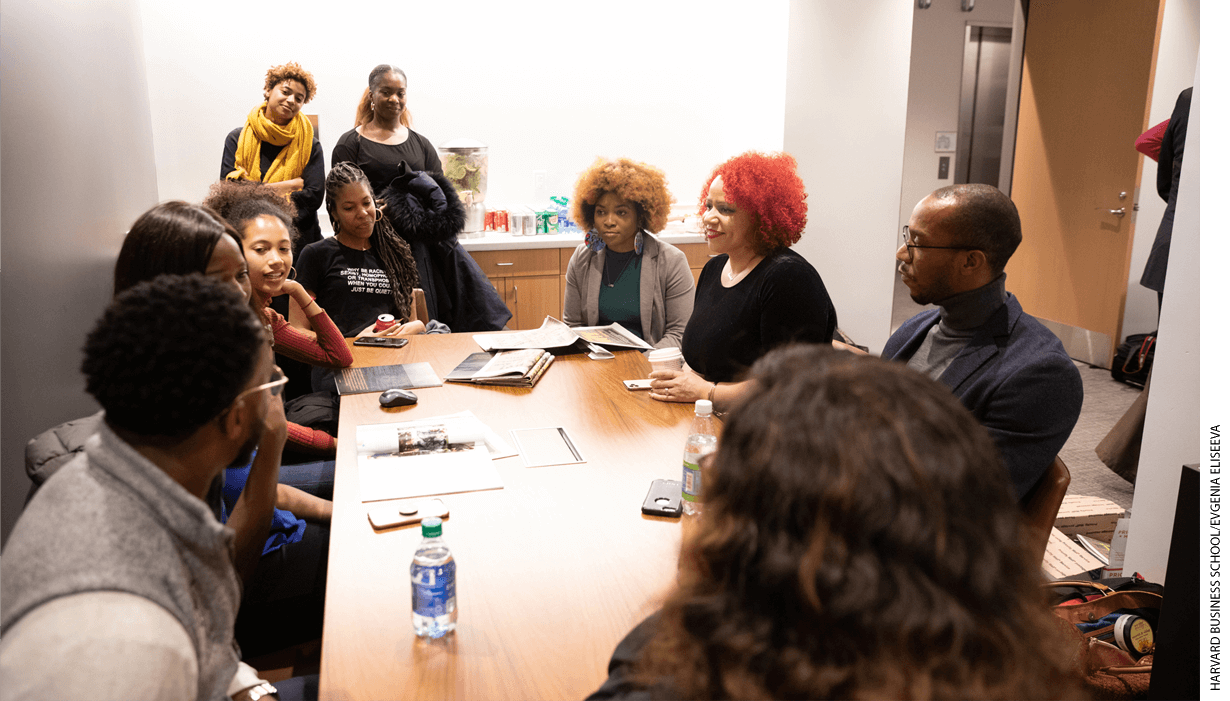
Members of the African American Student Union meeting with Nikole Hannah-Jones before an event at the Harvard Business School.
The 1619 Project and Capitalism
“The 1619 Project is not history: it is polemic, born in the imaginations of those whose primary target is capitalism itself and who hope to tarnish capitalism by associating it with slavery,” the historian Allen Guelzo writes in City Journal.
Indeed, a 1619 Project essay by Matthew Desmond, a professor in Princeton University’s department of sociology, asserts that “Slavery… helped turn a poor, fledgling nation into a financial colossus.” Desmond concludes in his 1619 essay: “If today America promotes a particular kind of low-road capitalism — a union-busting capitalism of poverty wages, gig jobs and normalized insecurity; a winner-take-all capitalism of stunning disparities not only permitting but awarding financial rule-bending; a racist capitalism that ignores the fact that slavery didn’t just deny black freedom but built white fortunes, originating the black-white wealth gap that annually grows wider — one reason is that American capitalism was founded on the lowest road there is.”
Hannah-Jones writes that “Profits from black people’s stolen labor helped the young nation pay off its war debts and financed some of our most prestigious universities. It was the relentless buying, selling, insuring and financing of their bodies and the products of their labor that made Wall Street a thriving banking, insurance and trading sector and New York City the financial capital of the world.”
Yet just as the Rev. Jesse Jackson’s Rainbow Push Coalition criticizes free-market capitalism while funding itself by soliciting lucrative sponsorships from businesses such as FedEx, Coca-Cola, Citibank, Boeing, and Wells Fargo, The 1619 Project is itself published by the New York Times Company, a for-profit enterprise whose shares are listed on the New York Stock Exchange. The Times has been trying to grow in the education market to compensate for dwindling print advertising revenues, operating a “School of The New York Times” with “faculty,” “admissions” and “financial aid,” issuing professional certificates in “content marketing” and “virtual reality,” and offering pre-college and gap year programs. As Gordon Crovitz, former publisher of the Wall Street Journal, tells me, “In an era when advertising doesn’t pay many of the bills, news operations are trying new ways to make the most of the trust their readers have in their brands.”
Hannah-Jones herself celebrated the Pulitzer by granting an interview to Conde Nast’s Glamour magazine about her self-care regimen. The article included her brand-name product endorsements—candles, body wash, bourbon, moisturizer. “I think beauty can seem frivolous, but beauty is also a political statement,” she said. “It is absolutely a political act to say, ‘ I have got to take care of myself so that I can continue to do the work that I hope will make this world a little bit better.’”
Hannah-Jones got a firsthand view of what a non-capitalist economy looks like in 2008, when she traveled to Havana. She returned to write an opinion article that spoke of “what Cuba has accomplished, through socialism and despite poverty, that the United States hasn’t.”
“Cuba boasts one of the highest literacy rates in the world,” the article said. “Education is the cornerstone of the revolution.” [For a more skeptical view of Cuba’s education system, please see “Cuban Schools: Too Good to Be True.”]
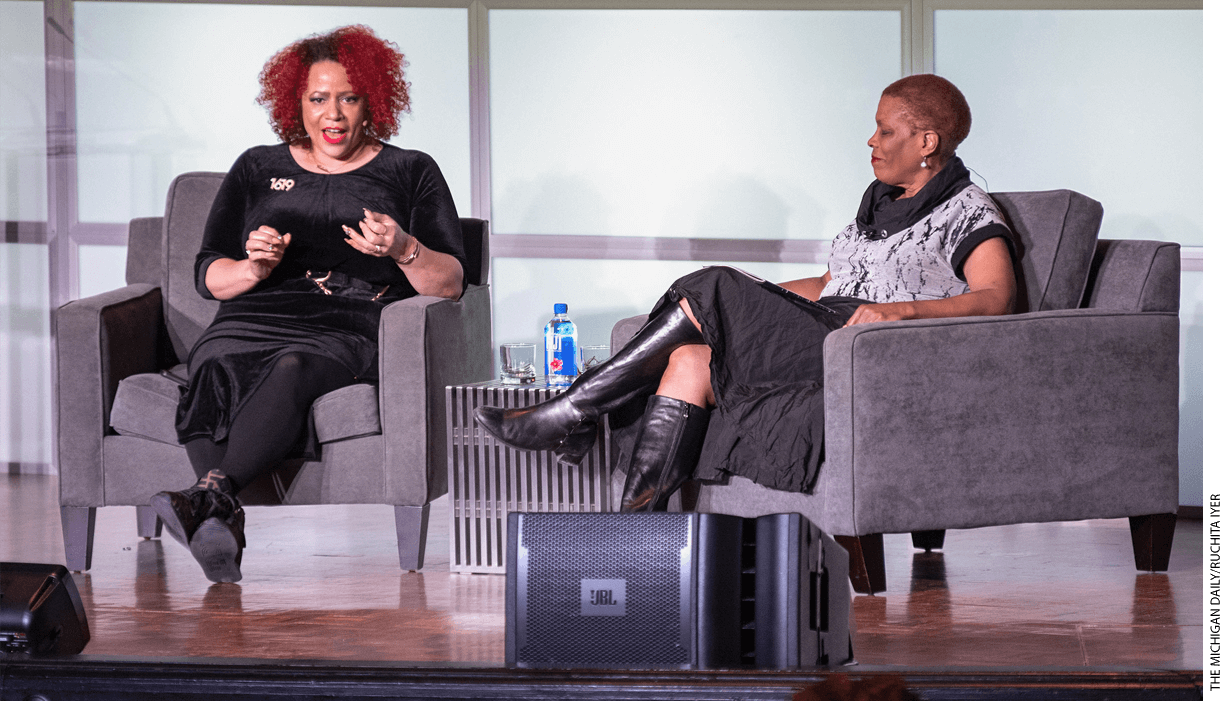
Nikole Hannah-Jones speaks at the University of Michigan in January 2020.
Celebrity Journalism
As the Glamour interview suggests, Hannah-Jones herself is an example of the phenomenon known as celebrity journalism, in which the journalist, Barbara Walters-style, becomes a star in her own right. Hannah-Jones burst into the national public eye in 2015. In an episode of the public radio show “This American Life,” she spoke movingly about how her experience covering segregation in education had been informed by her own childhood experience in Waterloo, Iowa, where she was one of a few black children bused to a predominantly white school on the other side of town. She told the show’s host, Ira Glass, that her white schoolmates refused to visit her neighborhood. “To this day, that devastates me. I’ll never forget how that felt,” she said.
Hannah-Jones also turned up as a central figure in a 2016 flap over remarks by Gay Talese, author of a classic 1969 book about the Times, The Kingdom and the Power. Talese, speaking at a narrative journalism conference, prompted a furor by bungling an answer to a question about women writers who had influenced his work. An article in the New York Times Thursday Styles section about the kerfuffle quoted Talese describing Hannah-Jones as “duplicitous” for having asked him to pose with her for a photograph while denouncing him on Twitter as a “sexist.” Talese asked, “Why did she have to ask for a selfie after what I said made her so upset?”
The executive editor of the Times, Dean Baquet, issued a press release on the Times Company website denouncing the Times article as “flawed,” “unfortunate,” and “clumsy.” Baquet wrote, “I hired Nikole because she is one of the most accomplished and prominent journalists of her generation. She has made it her mission to write about some of the most pressing, intractable issues in American life, particularly racial inequality in education and the re-segregation of American schools. She is a unique combination of a reporter with investigative zeal, unfailing integrity and a writer’s eye for telling, human detail. One of my proudest moments as editor was when Nikole said ‘yes’ and agreed to come to The Times.”
In a 2017 interview with the editor of the Atlantic, Jeffrey Goldberg, Goldberg asked Hannah-Jones, “If you were the dictator of America, would you outlaw private schools? Would you force all the white kids, and all the upper-middle class and upper-class African-American kids, into the public-school system? You’d have a deep level of parental involvement, right? Are private schools immoral in this context?” Hannah-Jones answered in part: “The answer to your question is yes, you would have to. If you truly wanted to equalize and integrate schools, you would have to.”
In 2017, at age 41, Hannah-Jones won a $625,000 MacArthur Foundation “genius” fellowship. A video interview with her posted on the MacArthur Foundation website explains her approach. “What we have seen is that racism, that racial motivations—they haven’t changed, but they have adapted to the times. As soon as we could no longer explicitly use race, we just found another way to do the same thing and to talk about the same things, with a sheen of deniability,” she said. “The inequality we see today is intentional. Many of us would like to believe that it’s all a legacy of our past, or it’s just a matter of income disparity. But I think what my work pretty systematically does is show that every day, leaders, policymakers, are making decisions that maintain inequality, particularly racial inequality, and that all of this is intentional, and very little of it is accidental.”
In this work, she keeps herself and her family in the foreground. In the MacArthur video, she says one of her most popular New York Times Magazine articles was one headlined, “Choosing a School for My Daughter in a Segregated City.” It was illustrated with a photograph of her then-six-year-old daughter. Hannah-Jones’s 1619 Project essay begins with her own family: “My dad was born into a family of sharecroppers on a white plantation in Greenwood, Miss., where black people bent over cotton from can’t-see-in-the-morning to can’t-see-at-night, just as their enslaved ancestors had done not long before.” In a speech accepting an award at Columbia University in 2018, Hannah-Jones said, “My grandmother was a domestic worker and a janitor and I remember walking to the courthouse with my dad and seeing my grandmother cleaning the windows. And all the people who would walk by her. As if she were invisible and didn’t matter.”
Just as America is increasingly becoming a place of individuals, not institutions—of hedge fund managers rather than investment banks, of free agents rather than anonymous team players, the New York Times is transitioning from its past as an “editor’s paper” to a present and future of being more of a “writer’s paper,” in which journalists are expected to develop individual voices, followings, and identities.
Identity Politics and “Oppression Studies”
With that identity may come identity politics, which has its own perils. A professor at Columbia, John McWhorter, in perhaps the most perceptive of all the essays yet written about The 1619 Project, wrote in Reason, “the 1619 idea joins many others in bolstering the black American soul with the substitute pride of noble victimhood. If you are a member of a race whose subjugation is part of the very DNA of the nation, it renders anything one does well a kind of victory snatched from the jaws of defeat (if only at generations’ remove) and in general lends one a way of feeling significant, distinct, special.”
McWhorter warned, “what is the actual purpose of teaching young people that a grievous injustice against black people is the very warp and woof of our polity? …black people will internalize an even deeper sense that America is not great and doesn’t like them, in the only country they will ever know. We are now to instruct black kids just a few years past diapers in this way of thinking—in studied despair over events far in the past, and a sense that it is more enlightened to think of yourself as a victim than as an actor. At no other point in human history have any people, under any degree of oppression, conceived of this kind of self-image as healthy.”
Healthy or not, it’s certainly inaccurate. The 1619 Project story draws straight lines between slavery and the aftermath of Hurricane Katrina, asking students to look at the similarities in poems about the two. Slavery, by that account, is directly responsible for mass incarceration, for healthcare disparities and a variety of other social ills that have befallen African Americans at disparate rates. There is little sense that there have been 160 years of history or public policy in the meantime. This conception gives short shrift to all the economic and social progress that African-Americans made during the 19th and 20th century. The black poverty rate fell to 29% from 87% between 1940 and 1980, as Stephan and Abigail Thernstrom wrote in America in Black and White. Median income rose faster for blacks than for whites between 1939 and 1960—568.5% versus 362% for men, according to statistics cited in Desegregating the Dollar, by Robert Weems. “Black Americans have made astounding progress, not only for ourselves but also for all Americans,” Hannah-Jones does finally concede in the 1619 Project essay, once she makes it past all the “rampant discrimination.” In a 2017 Vox interview, pressed by a questioner about a “sense of fatalism” that “robs people of their agency,” Hannah-Jones responded in part, “when people want hope, I wonder: Hope for what? To me, until black Americans are treated as full citizens, it’s immoral to expect people to be satisfied just because there’s forward progress. People want hope and absolution instead of working to destroy a system that still holds black people last in almost everything.”
Yet in contemporary America, victim status is so coveted and expanding that it increasingly seems less “distinct” or “special,” to use McWhorter’s words, than mundane, almost comical.
In May 2020, the Senate unanimously approved the Never Again Education Act, which had passed the House in January by a margin of 393 to 5. The law authorizes $10 million over 5 years to support education about the Holocaust. The legislation was passed with strong backing of Jewish organizations, but a professor emeritus of Yiddish at Harvard, Ruth Wisse, warned that it might be “dangerous” to present Jews as “humiliated” and “despised.” Wisse was echoing a caution that had been sounded by Lucy Dawidowicz, who, in a December 1990 Commentary article, “How They Teach the Holocaust,” observed that “history itself is under general beleaguerment in the secondary schools, “ being “squeezed out to make room for subject matter demanded by special-interest groups.” After all, she wrote, “Blacks have called for teaching about the role of blacks in American history and culture, and Hispanics, Native Americans, and women have followed suit, giving rise to what has irreverently been labeled ‘oppression studies.’”
Irish Americans soon joined the list, too. States including New York, California, New Jersey, Illinois and Connecticut passed laws requiring schools to teach about the Great Irish Famine. New York State’s official background materials for the famine material observe that “Study of the Great Irish Famine is part of a New York Human Rights curriculum that includes study of Slavery in the Americas and the Atlantic Slave Trade and the World War II era European Holocaust.”
Eventually the definition of victim groups grows to include the majority of the population. In May 2020, the New York Times kicked off “Unfinished Work,” a series of events, “Presented by MassMutual,” “investigating the ongoing battle for women’s rights in America. … we’ll explore the road to the 19th Amendment and the women who made it happen — including women of color whose work toward winning truly equal voting rights for all has been less celebrated. Then we’ll take a closer look at the legacy and impact of the 19th Amendment on the present-day fight for equality.”
“Most American of All”?
The Hannah-Jones essay is an at once an argument for black distinctiveness and for black American-ness. “More than any other group in this country’s history, we have served, generation after generation, in an overlooked but vital role: It is we who have been the perfecters of this democracy,” she writes. The essay concludes with the claim, “It was by virtue of our bondage that we became the most American of all.”
Most American of all? Or, both for better and for worse, just as American as anybody else? If there’s a bottom line to the story of The 1619 Project, it’s that in its lack of care with history, conflicted attitude toward capitalism, and embrace of celebrity and of identity politics, the venture seems less about perfecting America than about embodying some of its more exasperating and less constructive contemporary ailments.
Naomi Schaefer Riley is a resident fellow at the American Enterprise Institute.
get headlines https://thecherrycreeknews.com